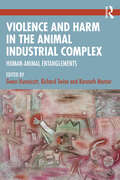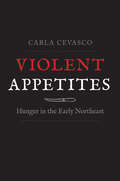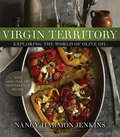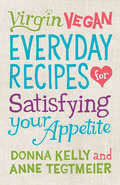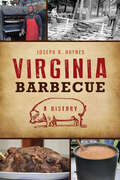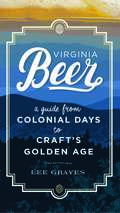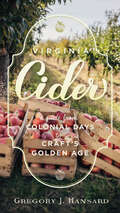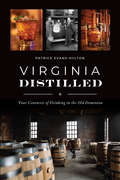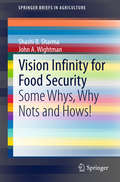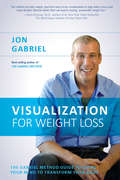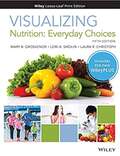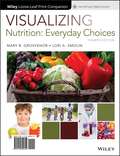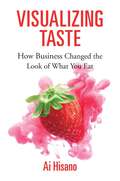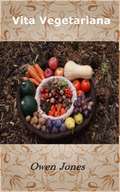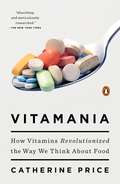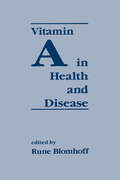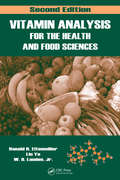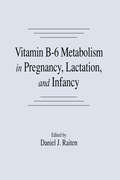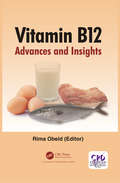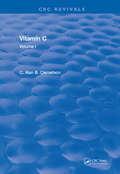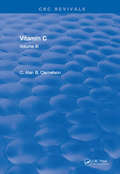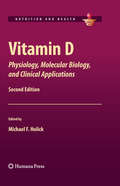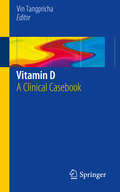- Table View
- List View
Violence and Harm in the Animal Industrial Complex: Human-Animal Entanglements
by Richard Twine Gwen Hunnicutt Kenneth MentorThis book grapples with multispecies violent exploitations embedded in corridors of power within the animal-industrial complex (A-IC). The A-IC is a useful framework for understanding how exploitative human-animal relations are central to capitalist relations and profit accumulation. ‘A-IC-related-violence’ – killing animals for economic gain – has a ripple effect which results in profound consequences for humans as well.This collection of international scholarship explores topics as varied as how A-IC-related-violence is reproduced and sustained through rapidly changing discursive strategies, ideological architecture, and particular cultural forms that elide and legitimize animal cruelty. Several chapters expose collusion between governments, corporations, and academia as central to maintaining dominance of A-IC-related-violence. Other scholars explore the trouble with making the conditions of “meat” production visible – of de-fetishizing meat commodities. The scholarship critically explores dynamic components of an apparatus that enables A-IC-related-violence and harm but is situated within the capitalist order and charts A-IC-related-violence as the key profit-generating practice in select domains of the A-IC.The book unmasks inherent cruelties in a proliferation of social forms that ultimately reflect a socioeconomic system that centralizes capitalist life characterized by endless growth, competitiveness, and profligate consumption. This is essential reading for those engaged in critical criminology, green criminology, violence studies, peace and conflict studies, critical animal studies, or animal rights-oriented scholars.
Violent Appetites: Hunger in the Early Northeast
by Carla CevascoHow hunger shaped both colonialism and Native resistance in Early America “In this bold and original study, Cevasco punctures the myth of colonial America as a land of plenty. This is a book about the past with lessons for our time of food insecurity.”—Peter C. Mancall, author of The Trials of Thomas Morton Carla Cevasco reveals the disgusting, violent history of hunger in the context of the colonial invasion of early northeastern North America. Locked in constant violence throughout the seventeenth and eighteenth centuries, Native Americans and English and French colonists faced the pain of hunger, the fear of encounters with taboo foods, and the struggle for resources. Their mealtime encounters with rotten meat, foraged plants, and even human flesh would transform the meanings of hunger across cultures. By foregrounding hunger and its effects in the early American world, Cevasco emphasizes the fragility of the colonial project, and the strategies of resilience that Native peoples used to endure both scarcity and the colonial invasion. In doing so, the book proposes an interdisciplinary framework for studying scarcity, expanding the field of food studies beyond simply the study of plenty.
Violent and Verdant: Systemic Injustice in Public Parks in the U.S. (New Critical Viewpoints on Society)
by KangJae Jerry LeePublic parks in the U.S. are one of the most contentious and paradoxical places. Many Americans believe public parks are encapsulations of nature, promoters of health, and embodiments of egalitarianism and democracy, providing a wide range of health, economic, cultural, and social benefits to users. Yet, the historical reality of American public parks has been riddled with greed, hypocrisy, prejudice, and ulterior motives of the rich and powerful. Numerous people have been displaced, exploited, and even killed because of public parks.Drawing from multiple disciplines such as sociology, history, geography, urban planning, environmental science, and leisure studies, Violent and Verdant: Systemic Injustice in Public Parks in the U.S. takes a two- pronged approach to provide critical and fresh insights on public parks in the U.S. It looks back, illuminating how parks have been sites of enduring violence and oppression. But it also looks forward, offering practical strategies and philosophical reimaginations of parks’ conception, development, and management.
Virgin Territory: Exploring the World of Olive Oil
by Nancy Harmon JenkinsAn illuminating look at olive oil with 100 recipes from the country's leading authority on the subject Olive oil is more popular than ever, thanks to its therapeutic and preventative effects in treating different diseases, as well as the growing variety of brands and imports available. Nancy Harmon Jenkins, arguably the leading authority on olive oil and the healthy Mediterranean diet, presents more than 100 dishes that showcase olive oil, ranging from soups to seafood to sauces to sweets. Along with favorites like tapenade and pesto, you'll find other exciting dishes like North African Seafood Tagine, Oven-Braised Artichokes with Potatoes and Onions, and Quince and Ginger Olive Oil Cake. But this book isn't just a collection of hearty and healthful recipes; Jenkins also covers the history and culture of olive oil as well as how to buy it and cook with it. A thing of beauty with the stunning photographs of exquisite dishes as well as Jenkin's own Tuscan olive tree grove, Virgin Territory captures the delights of making and cooking with olive oil.
Virgin Vegan: Everyday Recipes for Satisfying Your Appetite
by Donna Kelly Anne TegtmeierQuick and easy, tasty, vegan comfort food recipes for every meal of the day—plus condiments and sauces! New followers of a plant-based diet are often overwhelmed with the ingredients, recipes, and choices of a vegan lifestyle. And they often miss their favorite dishes from their old way of eating. Donna and Anne have created a cookbook that explains terms and new food items along with taking common comfort foods and quick recipes and making them vegan approved. With more than 100 recipes that include Pineapple Upside-Down Pancakes, Potato Corn Chowder, All-American Meatless Loaf, Mac and Cashew Cheese, and Chocolate Decadence Cheesefake, you are sure to make dining a pleasure.
Virginia Barbecue: A History (American Palate)
by Joseph R HaynesThe award-winning barbecue cook and author of Brunswick Stew shares the flavorful history of the Old Dominion&’s unique culinary heritage. With more than four hundred years of history, Virginians lay claim to the invention of southern barbecue. Native Virginian Powhatan tribes slow roasted meat on wooden hurdles or grills. James Madison hosted grand barbecue parties during the colonial and federal eras. The unique combination of vinegar, salt, pepper, oils and various spices forms the mouthwatering barbecue sauce that was first used by colonists in Virginia and then spread throughout the country. Today, authentic Virginia barbecue is regionally diverse and remains culturally vital. Drawing on hundreds of historical and contemporary sources, author, competition barbecue judge and award-winning barbecue cook Joe Haynes documents the delectable history of barbecue in the Old Dominion.
Virginia Beer: A Guide from Colonial Days to Craft's Golden Age
by Lee GravesThe days of choosing between a handful of imports and a convenience store six-pack are long gone. The beer landscape in America has changed dramatically in the twenty-first century, as the nation has experienced an explosion in craft beer brewing and consumption. Nowhere is this truer than in Virginia, where more than two hundred independent breweries create beers of an unprecedented variety and serve an increasingly knowledgeable, and thirsty, population of beer enthusiasts. As Lee Graves shows in his definitive new guide to Virginia beer, the Old Dominion’s central role in the current beer boom is no accident. Beer was on board when English settlers landed at Jamestown in 1607, and the taste for beer and expertise in brewing have only grown in the generations since. Graves offers an invaluable survey of key breweries throughout the Virginia, profiling the people and the businesses in each region that have made the state a rising star in the industry. The book is extensively illustrated and suggests numerous brewery tours that will point you in the right direction for your statewide beer crawl. From small farm breweries in the shadow of the Blue Ridge Mountains to cavernous facilities in urban rings around the state, Virginians have created a golden age for flavorful beer. This book shows you how to best appreciate it.
Virginia Cider: A Guide from Colonial Days to Craft's Golden Age
by Gregory J. HansardYour guide to the remarkable history, and ongoing popularity, of cider in the Commonwealth A cultural phenomenon with surprisingly deep roots, cider has been one of Virginia&’s favorite beverages for more than four hundred years, representing a time-honored ingredient of the cultural heritage that the first English settlers brought with them to America. Since the seventeenth century, apple orchards have been a fixture of the farming landscape, and cider was made and consumed by almost everyone—men, women, and children of all socioeconomic orders throughout the state&’s history. Recent decades have witnessed a renaissance of cider culture and cultivation, and today cider-making is a thriving craft-beverage industry, gaining ever-greater numbers of enthusiasts and connoisseurs as more and more cideries spring up every year. An essential title for the Virginian bookshelf, and for all readers interested in American cider: • The definitive history of making and drinking cider in Virginia • An in-depth guide profiling the cideries throughout the state, from Bold Rock to Big Fish, with &“Try This&” suggestions for each location, and a comprehensive map to help plan excursions • Brief descriptions of the varieties of apples preferred by Virginia&’s cider makers • In-depth overviews of everything from Home Cider Making to Laird & Company to Wassail
Virginia Distilled: Four Centuries of Drinking in the Old Dominion (American Palate)
by Patrick Evans-HyltonColonist George Thorpe first crafted "corn beere," an ancestor to bourbon, in 1620 at Berkeley Plantation, and George Washington once operated one of the nation's largest distilleries. Icy mint juleps were first served in Virginia until the state was one of the first to enact Prohibition. That dark period gave rise to bootlegging, moonshining and even NASCAR. Through well-documented research, interviews with key stakeholders and plenty of cocktail recipes for the reader to shake and stir at home, author Patrick Evans-Hylton showcases the rich history of four hundred years of drinking in the Commonwealth. Raise a glass to Virginia, birthplace of American spirits, and its long history of distilling and imbibing.
Vision Infinity for Food Security
by Shashi B. Sharma John A. WightmanA new perspective on the global food security situation and highlights the need for seeking a common vision and implementing global planning to define the manner in which the human species will manage its food security. The basic question of 'is there enough food' is examined in general and then in some detail. The history of food production is reviewed in the hope that lessons can be learned from the past. But even after ten thousand years of experience we are not able to feed adequately about a third of our total population, despite what statistics can be made to tell us. Intensive agriculture has stripped out the nutrients that support plant growth and marginalised extensive tracts of land. The global solution to feed the growing population has been and continues to be - produce more food. Even during the last 30 years, about 95 percent of global research investments have focused mainly on increasing productivity. However about a third of the food produced, sufficient to feed over two billion hungry people, is lost or wasted in the food value chain. Climate change is another confounding factor that impinges on our discussions. Pests of all kinds continue to destroy food before and after it is harvested, even though the technology to protect it is available. A huge amount of food is wasted in value chains, particularly at the domestic level. Global food production systems are exposed to unprecedented biosecurity risks posed by invasive harmful organisms and this trend is likely to further exacerbate as current approach to biosecurity is based on the notional premise that lines on maps and the legislation that goes with them is sufficient to halt epidemics. Solutions include extending the number of cultivated plant and animal species to include those that can prosper in what are currently considered to be extreme environments.
Visualization for Weight Loss: The Gabriel Method Guide To Using Your Mind To Transform Your Body
by Jon GabrielJoin best-selling author and international weight loss expert, Jon Gabriel, as he teaches you the visualization technique he used to shed 220 pounds without restrictive dieting or deprivation.Examining the importance of visualizing, Jon takes you through the latest research on the power of the mind in order to show why this technique is so effective for weight loss. With just a few minutes of visualization every day, you’ll learn how to: • Break free from negative beliefs and patterns around food • Reduce hunger and increase your metabolism • Overcome the stresses and emotional issues that can lead to weight gain • Rediscover the joy of movement • Create healthy habits for life • Eliminate junk food cravings and addictions • Improve your sleep and increase your energyAll of which lead to natural, enjoyable, and sustainable weight loss. Jon also teaches you how to create your own visualizations that apply to your unique life. And then he walks you through a 16-week transformational program that includes both visualizations and nutritional guidance.The big challenge, Jon discovered, is not finding the perfect diet or exercise routine; instead, it’s convincing your brain that it’s safe to let go of excess weight, which you can do with visualization. When that happens, it’s as if your body actually wants to be thin. And as Jon says, "There is nothing easier and more natural than losing weight when your body wants to be thin."
Visualizing Nutrition: Everyday Choices
by Mary B. Grosvenor Lori A. Smolin ChristophVisualizing Nutrition: Everyday Choices, WileyPLUS NextGen Card with Loose-leaf Set, 5th Edition delivers a comprehensive exploration of nutritional science, food's impact on society and culture, and the ways in which dietary choices affect health and well-being. The latest edition combines brand-new content on the 2020-2025 Dietary Guidelines for Americans with access to the recently launched WileyPLUS NextGen digital learning environment.
Visualizing Nutrition: Everyday Choices
by Mary B. Grosvenor Lori A. SmolinVisualizing Nutrition, 2nd Edition is intended for a one-term course in introductory Nutrition taught at both two- and four-year schools. This text offers students a valuable opportunity to identify and connect the central issues of nutritional science in a visual approach. The material provides students with the decision-making skills needed throughout their lifespan to navigate the myriad of choices they will face in promoting their good health and in preventing disease. As students apply the thought processes and decision-making skills learned throughout the course, they come to understand that there are not “good” foods and “bad” foods, but rather that each choice is only part of an overall healthy diet and that it is the sum of those choices that determines good nutrition. The new edition has been completely updated to include updated coverage and information on the latest Dietary Guidelines for Americans 2010 and all of the MyPlate information. (www.choosemyplate.gov)
Visualizing Taste: How Business Changed the Look of What You Eat (Harvard studies in business history ; #53)
by Ai HisanoAi Hisano reveals how the food industry capitalized on color, fashioning a visual vocabulary that shapes what we think of the food we eat. Our perceptions of what food should look like have changed dramatically as scientists, farmers, food processors, regulators, and marketers established a new, and highly engineered, version of the “natural.”
Vita vegetariana (Come fare... #125)
by Owen JonesVita vegetariana Ciao e grazie per aver acquistato questo ebook chiamato "Vegetarian Life". Questo non è un libro di ricette, sebbene parli di cibo vegetariano e fornisca alcune ricette di esempio. Spero che le informazioni siano utili, dirette e redditizie. Le informazioni contenute in questo ebook sul vegetarismo e argomenti correlati sono organizzate in 15 capitoli di circa 500-600 parole ciascuno. Come bonus aggiuntivo, vi concedo il permesso di utilizzare i contenuti sul vostro sito Web o nei vostri blog e newsletter, anche se è meglio se li riscrivete prima con le vostre parole. Potete anche dividere il libro e rivendere gli articoli. In effetti, l'unico diritto che non avete è di rivendere o regalare il libro come vi è stato consegnato. Se avete qualche feedback, vi preghiamo di lasciarlo alla società da cui avete acquistato questo libro. Grazie ancora per aver acquistato questo ebook, Saluti, Owen Jones
Vitamania: Our Obsessive Quest For Nutritional Perfection
by Catherine Price"A hidden, many-faceted, and urgent story." --Booklist, *STARRED*Most of us know nothing about vitamins. What's more, what we think we know is harming both our personal nutrition and our national health. By focusing on vitamins at the expense of everything else, we've become blind to the bigger picture: despite our belief that vitamins are an absolute good--and the more of them, the better--vitamins are actually small and surprisingly mysterious pieces of a much larger nutritional puzzle. In Vitamania, award-winning journalist Catherine Price offers a lucid and lively journey through our cherished yet misguided beliefs about vitamins, and reveals a straightforward, blessedly anxiety-free path to enjoyable eating and good health.When vitamins were discovered a mere century ago, they changed the destiny of the human species by preventing and curing many terrifying diseases. Yet it wasn't long before vitamins spread from labs of scientists into the realm of food marketers and began to take on a life of their own. By the end of the Second World War, vitamins were available in forms never before seen in nature--vitamin gum, vitamin doughnuts, even vitamin beer--and their success showed food manufacturers that adding synthetic vitamins to otherwise nutritionally empty products could convince consumers that they were healthy. The era of "vitamania," as one 1940s journalist called it, had begun.Though we've gained much from our embrace of vitamins, what we've lost is a crucial sense of perspective. Vitamins may be essential to our lives, but they are not the only important substances in food. By buying into a century of hype and advertising, we have accepted the false idea that particular dietary chemicals can be used as shortcuts to health--whether they be antioxidants or omega-3s or, yes, vitamins. And it's our vitamin-inspired desire for effortless shortcuts that created today's dietary supplement industry, a veritable Wild West of overpromising "miracle" substances that can be legally sold without any proof that they are effective or safe.For the countless individuals seeking to maximize their health and who consider vitamins to be the keys to well-being, Price's Vitamania will be a game-changing look into the roots of America's ongoing nutritional confusion. Her travels to vitamin manufacturers and food laboratories and military testing kitchens--along with her deep dive into the history of nutritional science-- provide a witty and dynamic narrative arc that binds Vitamania together. The result is a page-turning exploration of the history, science, hype, and future of nutrition. And her ultimate message is both inspiring and straightforward: given all that we don't know about vitamins and nutrition, the best way to decide what to eat is to stop obsessing and simply embrace this uncertainty head-on.By exposing our extraordinary psychological rela¬tionship with vitamins and challenging us to question our beliefs, Vitamania won't just change the way we think about vitamins. It will change the way we think about food.From the Hardcover edition.
Vitamin A in Health and Disease (Antioxidants in Health and Disease)
by Rune BlomhoffThis book is intended as a source of information for the many scientists who now enter the growing research field of vitamin A in health and disease, reviewing the epidemiological aspects related to vitamin A.
Vitamin Analysis for the Health and Food Sciences
by Lin Ye Ronald R. Eitenmiller W. O. Landen Jr.Employing a uniform, easy-to-use format, Vitamin Analysis for the Health and Food Sciences, Second Edition provides the most current information on the methods of vitamin analysis applicable to foods, supplements, and pharmaceuticals. Highlighting the rapid advancement of vitamin assay methodology, this edition emphasizes the use of improved
Vitamin B-6 Metabolism in Pregnancy, Lactation, and Infancy
by Daniel J. RaitenThis book provides a comprehensive review of our knowledge of vitamin B-6 requirements and metabolism throughout pregnancy and lactation. It concentrates on two primary points: adequacy of available methodologies and a presentation of the extant knowledge on vitamin B-6 metabolism and requirements in pregnancy, infancy, lactation, and in women of childbearing age. Many of the chapters offer new perspectives on how decisions have been and are being made with regard to the establishment of dietary recommendations about vitamin B-6 and the adequacy of research to support these decisions.
Vitamin B12: Advances and Insights
by Rima ObeidCobalamin (vitamin B12) was discovered in the first half of the 20th century. Vast amount of information on the role of the vitamins in human health and disease became available. Cobalamin science was, however, based on theoretical concepts that have been accepted without further proof of facts and hypotheses. Recently, the breath-taking pace of development in research technologies has changed our understanding for the role of nutrients and the complex interaction between diet, environment and diseases. Conditions like aging, diet and drugs increase the risk of developing cobalamin deficiency, probably because of diminished ability to liberate, absorb or distribute the food-derived vitamin. From a basic science point of view, understanding of the transport and function of the vitamin, may pave the road for using this system for drug delivery. This book represents up-to-date literature on the discoveries and developments in the field of cobalamin. It includes multifaceted aspects of the vitamin in health and disease conditions. The book has been written by leading scientists who have significant contributions in this field and represents therefore, a timely unique encyclopaedia on cobalamin.
Vitamin C: Volume I
by Alan B. ClemetsonThe factors affecting blood vitamin C levels are described in detail in this series. Many factors such as aging, smoking, infection, trauma, surgery, hemolysis, hormone administration, heavy metals, pregnancy, alcohol, ionizing radiation and several medicines have been found to cause a disturbance of ascorbic acid metabolism and to reduce blood vitamin C levels. Indeed, abnormalities of ascorbic acid metabolism, due to factors such as smoking, occur much more frequently than does dietary vitamin C deficiency today.It is now known that low blood vitamin C levels are associated with histaminemia (high blood histamine levels), and also that ascorbate-responsive histaminemia is common in apparently healthy people. High blood histamine levels are believed to cause small hemorrhages within the inner walls of the blood vessels and these may lead to the deposition of cholesterol, as an aberrant form of wound healing. Ascorbic acid not only reduces blood histamine levels, but also aids the conversion of cholesterol to bile acids in the liver. The clinical pathological and chemical changes observed in ascorbic acid deficiency are discussed in detail. Several diseases and disorders associated with low blood vitamin C levels are also described. Possible toxic effects resulting from the oxidation of ascorbic acid are noted, and reasons for the use of D-catechin or other chelating fiber to prevent or minimize the release of ascorbate-free radical are detailed. An excellent reference for physicians, nutritionists and other scientists
Vitamin C: Volume II
by Alan B. ClemetsonThe factors affecting blood vitamin C levels are described in detail in this series. Many factors such as aging, smoking, infection, trauma, surgery, hemolysis, hormone administration, heavy metals, pregnancy, alcohol, ionizing radiation and several medicines have been found to cause a disturbance of ascorbic acid metabolism and to reduce blood vitamin C levels. Indeed, abnormalities of ascorbic acid metabolism, due to factors such as smoking, occur much more frequently than does dietary vitamin C deficiency today.It is now known that low blood vitamin C levels are associated with histaminemia (high blood histamine levels), and also that ascorbate-responsive histaminemia is common in apparently healthy people. High blood histamine levels are believed to cause small hemorrhages within the inner walls of the blood vessels and these may lead to the deposition of cholesterol, as an aberrant form of wound healing. Ascorbic acid not only reduces blood histamine levels, but also aids the conversion of cholesterol to bile acids in the liver. The clinical pathological and chemical changes observed in ascorbic acid deficiency are discussed in detail. Several diseases and disorders associated with low blood vitamin C levels are also described. Possible toxic effects resulting from the oxidation of ascorbic acid are noted, and reasons for the use of D-catechin or other chelating fiber to prevent or minimize the release of ascorbate-free radical are detailed. An excellent reference for physicians, nutritionists and other scientists
Vitamin C: Volume III
by Alan B. ClemetsonThe factors affecting blood vitamin C levels are described in detail in this series. Many factors such as aging, smoking, infection, trauma, surgery, hemolysis, hormone administration, heavy metals, pregnancy, alcohol, ionizing radiation and several medicines have been found to cause a disturbance of ascorbic acid metabolism and to reduce blood vitamin C levels. Indeed, abnormalities of ascorbic acid metabolism, due to factors such as smoking, occur much more frequently than does dietary vitamin C deficiency today.It is now known that low blood vitamin C levels are associated with histaminemia (high blood histamine levels), and also that ascorbate-responsive histaminemia is common in apparently healthy people. High blood histamine levels are believed to cause small hemorrhages within the inner walls of the blood vessels and these may lead to the deposition of cholesterol, as an aberrant form of wound healing. Ascorbic acid not only reduces blood histamine levels, but also aids the conversion of cholesterol to bile acids in the liver. The clinical pathological and chemical changes observed in ascorbic acid deficiency are discussed in detail. Several diseases and disorders associated with low blood vitamin C levels are also described. Possible toxic effects resulting from the oxidation of ascorbic acid are noted, and reasons for the use of D-catechin or other chelating fiber to prevent or minimize the release of ascorbate-free radical are detailed. An excellent reference for physicians, nutritionists and other scientists
Vitamin D
by Michael F. HolickIn Vitamin D: Physiology, Molecular Biology, and Clinical Applications, Second Edition, leading researchers provide a comprehensive, highly readable overview of the biological functions and clinical applications of vitamin D and its metabolites. Topics range from the most recent recommendations for vitamin D intake to new approaches for the treatment and prevention of vitamin D deficiency and the development of active vitamin D drugs to treat psoriasis and cancer. The book demonstrates the significant role that vitamin D has in maintaining good bone health and the prevention of osteoporosis, an important health problem for adults over the age of fifty. In addition, it authoritatively reviews the relationship between sunlight exposure, vitamin D, and increased risk of colon and breast cancer; how vitamin D is made in the skin; and the sequence of events that leads to its activation by the kidney. Also examined are the biological functions of 1,25-dihydrovitamin D3 on the intestine and bone, as well as other tissues, such as skin, the immune system, prostate, and breast, and vitamin D's molecular mechanism of action on the cell membrane and nucleus. The first edition of Vitamin D: Physiology, Molecular Biology and Clinical Applications was the benchmark in the field when published in 1999. This new and expanded volume continues to include extensive, in-depth chapters covering the most important aspects of the complex interactions between vitamin D and other dietary components, the ongoing debate concerning the best indicator of optimal vitamin D status and its nutrient requirements, and the impact of less than optimal status on disease risk. Vitamin D: Physiology, Molecular Biology, and Clinical Applications, Second Edition is designed and organized not only to be an up-to-date review on the subject, but also to provide medical students, graduate students, health care professionals and even the lay public with a reference source for the most up-to-date information about the vitamin D deficiency pandemic and its clinical implications for health and disease.
Vitamin D
by Vin TangprichaComprised exclusively of clinical cases covering disorders of vitamin D and its clinical management, this concise, practical casebook will provide clinicians in endocrinology with the best real-world strategies to properly diagnose and treat the various forms of the condition they may encounter. Each chapter is a case that opens with a unique clinical presentation, followed by a description of the diagnosis, assessment and management techniques used to treat it, as well as the case outcome and clinical pearls and pitfalls. Cases included illustrate different causes of deficiency as well as management strategies, including deficiency in healthy patients and infants, in eating disorders and gastric bypass, surgical and chronic hypoparathyroidism, and chronic kidney disease, among others. Pragmatic and reader-friendly, Vitamin D: A Clinical Casebook will be an excellent resource for clinical endocrinologists, nutritionists, and family and emergency medicine physicians alike.
